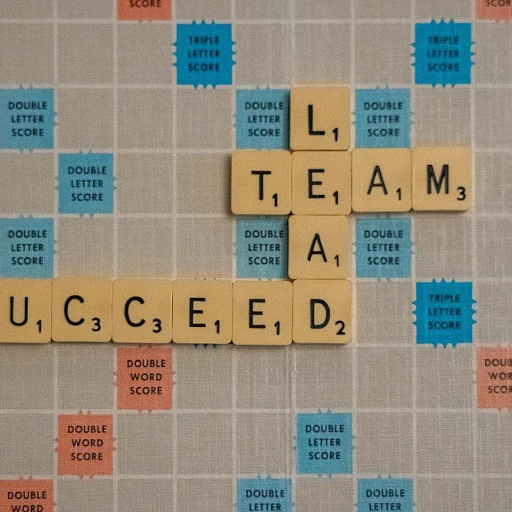Understanding the Importance of Employee Goals
The Significance of Setting Goals in the Workplace
Understanding the importance of employee goals is crucial for both individual success and the overall growth of an organization. Goals serve as a roadmap, guiding employees on their professional development journey and aligning their personal objectives with the broader ambitions of the company. The setting of clear and achievable goals not only enhances performance management but also boosts employee engagement and satisfaction.
Effective goal setting helps employees focus on key areas for improvement, fostering skills such as problem-solving, customer service, and soft skills development. When employees work with defined objectives, there's an increase in motivation and accountability, making the journey towards achieving these targets more rewarding for both team members and the organization as a whole.
Moreover, linking employee goals with company-wide objectives aids in ensuring that everyone is moving in a unified direction, ultimately leading to improved performance across departments. The strategic alignment of individual and organizational goals is pivotal—it empowers employees to contribute to significant projects, enhancing both individual progress and overall team performance.
Performance reviews then serve as a checkpoint to assess the progress of these set goals, providing an opportunity to evaluate success and identify areas for further development. These reviews are essential for not only maintaining a continuous feedback loop but also adjusting goals as needed to keep pace with changing business environments.
For organizations keen on mastering performance improvement plans, understanding the intricacies of goal setting is vital. These plans can be further explored through
mastering the art of performance improvement plan training, a valuable resource for HR professionals seeking enhanced outcomes in performance reviews.
Types of Employee Goals
Exploring Various Forms of Employee Goals
Setting performance goals can be a nuanced process, given the diverse array of purposes these goals can serve within an organization. Understanding the different types of goals is key to crafting effective goals that truly fit the needs of both the employees and the organization.
Performance goals commonly take the form of task-based objectives. These are specifically designed to direct employees’ daily activities, driving productivity and enhancing team outputs. They might focus on key skills development or the accomplishment of specific projects within a given time frame. For example, an employee might be tasked with enhancing customer service metrics or completing a major project aimed at improving customer satisfaction levels.
Another important category involves developmental goals. These goals aim to improve soft skills and promote the professional development of employees. These might involve setting specific targets for leadership development, problem solving, or other skills that are essential within the organization’s context. Effective goal setting in this area involves a clear focus on measurable outcomes that align with an employee's career aspirations and the organization's strategic objectives.
Additionally, setting performance goals that align an employee's work with the broader company objectives is vital. This alignment not only boosts employee engagement but also ensures that the entire organization is propelled towards shared visions. Accordingly, goals should be SMART (specific, measurable, achievable, relevant, and time-bound) to facilitate effective management and evaluation of progress.
By exploring different types of employee goals, leaders can foster a more comprehensive review process during performance reviews, ultimately driving sustainable success. For more insights and
examples of performance goals, professionals can consult resources that provide deeper understanding of crafting such goals.
Aligning Goals with Company Objectives
Ensuring Goals Align Seamlessly with Company Objectives
In the corporate world, aligning individual goals with overarching company objectives is a critical component of effective performance management. This alignment not only fosters a sense of purpose among employees but also directly contributes to the broader success of the organization. Understanding the importance of this synergy can significantly enhance employee engagement and drive business outcomes positively.
Ensuring that employee goals complement company objectives can be achieved through various methods:
- Identify Key Objectives: Begin by outlining the company’s primary goals that need attention. These could range from improving customer satisfaction to enhancing product quality. Subsequently, employee goals should be crafted in a manner that supports these strategic objectives.
- Break Down Goals: Use SMART goals (Specific, Measurable, Achievable, Relevant, Time-bound) to construct clear, actionable objectives. By making goals more attainable, employees can better understand their contributions to the company marks.
- Foster Team Collaboration: Encourage team members to work together on projects that align with company goals. Collaborative efforts can enhance both individual and team performance, leading to improved outcomes and innovation.
- Regular Communication: Engage in continuous dialogue about goal progress and company objectives. This practice ensures everyone is on the same page and highlights areas needing adjustment. Reviewing goals frequently during performance reviews can keep the alignment process dynamic and responsive.
Additionally, integrating HR technology solutions into the goal-setting process can streamline the alignment of employee goals with company objectives. Modern tools offer features to track progress, identify key performance indicators and adjust goals timely. This technological integration facilitates a seamless connection between individual efforts and organizational aims, ultimately improving the management of both employee performance and professional development.
For more on enhancing goal alignment with company objectives, consider exploring more about
setting performance for a detailed understanding of facilitating effective employee goals.
Utilizing HR Tech for Goal Setting
Integrating Technology in Goal Setting for Enhanced Outcomes
The incorporation of HR technology in goal setting has revolutionized the way organizations approve and track employee objectives. This technological advancement facilitates a more streamlined approach to ensure alignment with company objectives, thereby boosting overall employee performance. Let's explore how this transformation is achieved.
Technology serves as a cornerstone for facilitating clear communication about goals and expectations between management and employees. It enables team members to easily access their performance goals, allowing for regular review and adjustments. By using digital platforms, management can efficiently set, monitor, and adjust goals in real-time, ensuring that these goals remain relevant as projects evolve.
Moreover, HR tech tools allow employees to receive timely feedback, a crucial element in the development of both soft skills and technical competencies. This instant feedback mechanism fosters a culture of continuous improvement and professional development. Employees are encouraged to engage in problem-solving activities, effectively driving their progress and promoting a sense of ownership over their responsibilities.
A notable benefit of utilizing HR technology in setting performance goals is the ability to tailor goals to individual strengths and areas for improvement. For example, customer service employees can focus their goals around enhancing customer satisfaction and problem resolution skills. Such tailored approach ensures that everyone’s personal development aligns with the organization's key objectives.
To enhance transparency and reduce manual errors, these tech platforms often include features for tracking the progress of set goals. Such visibility enables both managers and employees to understand how individual contributions impact the organization at large, thereby fostering employee engagement and retention.
Through automation, teams can save time on administrative tasks and invest it in more strategic activities that contribute directly to achieving the organization’s mission. HR tech emerges as a game-changer, catalyzing performance management by setting SMART goals—Specific, Measurable, Achievable, Relevant, and Time-bound—ensuring efficient goal-setting processes and successful performance reviews.
In summary, integrating HR technology in goal setting not only boosts an organization's effectiveness but also sharpens the focus on continual growth and customer satisfaction. This integration is not just an option but a necessity for any forward-thinking organization looking to thrive in today’s competitive environment.
Examples of Effective Employee Goals
Illustrative Instances of Successful Goal Formulation
Crafting examples of effective employee goals can be a transformative strategy, steering employees and entire teams toward peak performance. Here, clarity and specificity play pivotal roles in goal setting, ensuring alignment with company objectives and fulfilling the employees' development aspirations.
Consider these goal examples in different areas:
- Performance Goals: A sales employee might aim to increase customer satisfaction scores by 10% over the next quarter, aligning with the broader key organizational objectives.
- Project Completion: A project manager may set the goal to deliver the ongoing project two weeks ahead of schedule, enhancing overall team performance and meeting customer expectations.
- Professional Development: Encourage team members to engage in soft skills workshops to refine their problem-solving or customer service capabilities, fostering an enriched workplace environment.
- Technical Skills: An IT team member could work towards obtaining a certification in a new programming language, thus contributing to the team’s adaptive readiness in tech advancement.
These goal examples underscore the essence of SMART goals—Specific, Measurable, Achievable, Relevant, and Time-bound. The integration of such structured objectives within an organization’s performance goals enhances employee engagement and directs focus toward continuous improvement.
Translating these examples into everyday work instills a culture of performance management and motivates employees to pursue excellence in their roles. Encourage teams to regularly review goals, assess progress, and adjust strategies as needed, ensuring sustained alignment with the evolving business landscape.
Overcoming Challenges in Goal Setting
Addressing and Overcoming Challenges in Setting Goals
Setting effective performance goals for employees can be a challenging task. Balancing individual aspirations with company objectives while ensuring that goals contribute effectively to team and organizational performance requires careful consideration. Here are some common challenges faced in goal setting and strategies to overcome them:
- Misalignment with Company Objectives: One of the critical challenges is ensuring that individual goals align with broader company objectives. To address this, involve employees in goal discussions, clearly communicate organizational priorities, and emphasize the importance of aligning personal aspirations with those goals.
- Vague or Unrealistic Goals: Goals that are too broad or unrealistic can create confusion and hamper progress. Employing the SMART (Specific, Measurable, Achievable, Relevant, Time-bound) framework can help in outlining clear and attainable goals that accurately reflect desired outcomes and employee skills.
- Lack of Employee Engagement: Engaging employees in the goal-setting process is vital. Encouraging participation and input from team members in establishing their own performance goals helps increase commitment and motivation.
- Difficulty in Measuring Progress: Monitoring progress effectively can be challenging. Establishing regular check-ins and using performance management technology can provide continuous feedback and highlight areas needing improvement.
- Inadequate Skill Development: Some goals may require employees to acquire new skills. Facilitating employee development through training programs, mentoring, and providing access to learning resources can enhance problem solving and customer service skills, thereby supporting the achievement of performance goals.
- Balancing Individual and Team Goals: Coordinating between an individual's personal performance goals and team objectives can be complex. Promote open communication within the team to ensure everyone is working towards common targets and understands their role in achieving them.
Understanding these challenges and approaching goal setting thoughtfully can significantly improve both employee performance and job satisfaction, ultimately benefiting the whole organization as progress is measured and adjusted over time.














